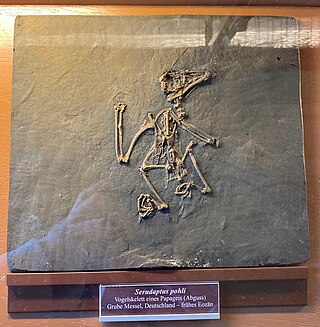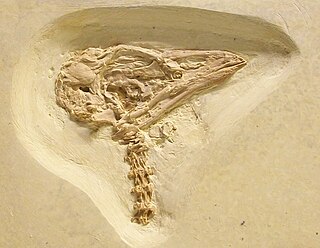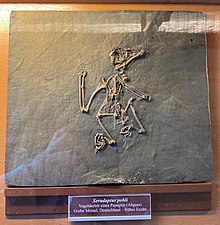
Palaeotis is a genus of paleognath birds from the middle Eocene epoch of central Europe. One species is known, Palaeotis weigelti. The holotype specimen is a fossil tarsometatarsus and phalanx. Lambrect (1928) described it as an extinct bustard, and gave it its consequent name. After a suggestion by Storrs L. Olson, a review of the type specimen and the referral of several other fossils by Houde and Haubold (1987) concluded that Palaeotis is a palaeognath and assigned it to the same order as ostriches; the Struthioniformes. In 2021, it was considered a member of the family Paleotididae alongside Galligeranoides from the Early Eocene of France, which were found to be basal members of the Struthioniformes.

Masillaraptor is an extinct genus of masillaraptorid, a group of primitive falconiforms, from the Middle Eocene Messel Pit, Germany. It is a long-legged relative of the living falcons.

Odontopteryx is a genus of the extinct pseudotooth birds or pelagornithids. These were probably rather close relatives of either pelicans and storks, or of waterfowl, and are here placed in the order Odontopterygiformes to account for this uncertainty.

Palaeoglaux is a genus of fossil owls from the Eocene epoch. The two known species are P. perrierensis from the Upper Eocene of Quercy, France, and P. artophoron from the Middle Eocene Messel shales, Germany. The holotype of P. perrierensis is a partial left coracoid in the Collection Université Montpellier, accession number PRR 2585. The four paratypes are the distal part of a left humerus (PRR2591), the proximal part of a left ulna, the distal part of a left ulna, and the distal part of a right tarsometatarsus. The type specimen of P. artophoron is a fossil slab and counterslab containing most of the postcranial skeleton and some feather impressions. This specimen is in the collection of the Forschunginstitut Senckenberg, accession number SMF-ME 1144 A and B.
Eurofluvioviridavis is a genus of extinct primitive birds from the Middle Eocene Messel Pit, Germany. It contains a single species, Eurofluvioviridavis robustipes. It is related to Avolatavis and Vastanavis, other members of the family Vastanavidae.

Messelasturidae is an extinct family of birds known from the Eocene of North America and Europe. Their morphology is a mosaic that in some aspects are very similar to modern hawks and falcons, but in others are more similar to parrots. Initially interpreted as stem-owls, more recent studies have suggested a closer relationship to parrots and passerines. Their ecology is enigmatic.

Halcyornithidae is an extinct family of telluravian birds thought to be related to the Psittaciformes (parrots), Passeriformes (songbirds), and to the extinct Messelasturidae. Halcyornithids have been found in various Eocene formations in Europe and North America. Widespread and diverse in the Early Eocene of North America and Europe, halcyornithids are not found in locales later than the Middle Eocene. Halcyornithids were small, arboreal birds with zygodactyl feet, with two toes facing forwards and two facing back, a trait shared with other tree-dwelling families of Eocene birds like the Zygodactylidae and the messelasturids. The skull of halcyornithids features a ridge of bone above the eye called the supraorbital process, similar to birds of prey. The relationships of the halcyornithids to other birds remain uncertain. Halcyornithids have been proposed as relatives to owls and as a lineage closer to parrots than to songbirds. Most recently, halcyornithids have been identified as the sister group of the clade including parrots and songbirds. It is also possible that Halcyornithidae is paraphyletic with respect to the Messelasturidae.
Morsoravis is an extinct genus of neoavian bird from the Early Eocene Fur Formation of Denmark. It contains a single named species, Morsoravis sedilis. Fossils of Morsoravis have also been found in the Green River Formation of Wyoming and possibly the Nanjemoy Formation of Virginia.

Scaniacypselus is an extinct genus of basal swifts from the Eocene of Denmark, Germany and France. Many well preserved specimens still showing plumage were discovered in the Messel Pit near Darmstadt, Germany. Species of Scaniacypselus had relatively broader wings than modern swifts and hindlimbs better adapted to perching on tree-branches, indicating that the bird was not as aerial as its extant relatives and likely nested in trees like hummingbirds and treeswifts. Two species are recognized, S. wardi and S. szarskii.

Tonsala is an extinct genus of Plotopteridae, a family of flightless seabird similar in biology with penguins, but more closely related to modern cormorants. The genus is known from terrains dated from the Late Oligocene of the State of Washington and Japan.

Ypresiglaux is an extinct genus of strigiform bird from the Early Eocene London Clay Formation of Essex, United Kingdom and Nanjemoy Formation of Virginia, United States. The genus contains two species: Y. michaeldanielsi, known from a partial skeleton, and Y. gulottai, known from a distal tarsometatarsus.

Lutavis is an extinct genus of potentially afroavian bird from the Early Eocene London Clay Formation of Essex, United Kingdom. The genus contains a single species, L. platypelvis, known from a partial skeleton.

Olympidytes is an extinct genus of Plotopteridae, a family of large, flightless marine bird superficially similar to modern penguins but more closely related to cormorants and gannets. It lived during the Late Eocene or the Early Oligocene, in what is today the State of Washington and Japan.

Klallamornis is an extinct genus of Plotopteridae, a family of large, flightless birds related to modern cormorants, darters, gannets, and boobies. This genus included the largest North American plotopterids. Its remains can be found in Late Eocene to Late Oligocene rocks from the Makah Formation, the overlying Pysht Formation and the Lincoln Creek Formation of the State of Washington. During its existence, Klallamornis was the largest plotopterid on the North American continent. The first fossil remains attributed to the taxon were collected in 1983, although the genus wasn't described until 2016.

Cyrilavis is an extinct genus of halcyornithid bird from the Early Eocene Fossil Butte Member of the Green River Formation, United States. The genus contains two species, Cyrilavis olsoni and Cyrilavis colburnorum.
Pulchrapollia is an extinct genus of halcyornithid bird from the Early Eocene London Clay of Walton-on-the-Naze, United Kingdom and the Nanjemoy Formation of Virginia, United States. The genus contains three species, Pulchrapollia gracilis, Pulchrapollia tenuipes and Pulchrapollia eximia.
Pseudasturides is an extinct genus of halcyornithid bird from the Middle Eocene Messel pit in Hesse, Germany, and possibly the Isle of Sheppey, United Kingdom. The genus is represented by a single species, Pseudasturides macrocephalus.
Parapsittacopes is an extinct genus of psittacopedid bird from the Early Eocene London Clay, United Kingdom. The genus contains one species, Parapsittacopes bergdahli.
Eofringillirostrum is an extinct species of bird known from the Early Eocene Green River Formation of the Western United States and from the Messel Pit in Germany. The genus contains two species, Eofringillirostrum boudreauxi and Eofringillirostrum parvulum. They are the earliest known fossil birds to have a finch-like beak.
Sororavis is an extinct genus of bird from the Early Eocene London Clay of Walton-on-the-Naze, United Kingdom. It contains a single named species, Sororavis solitarius. It is a member of the Morsoravidae.













